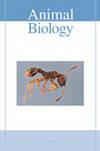囊虫病侵袭对家兔蛋白质代谢及细胞免疫的影响
IF 0.9
4区 生物学
Q2 ZOOLOGY
引用次数: 0
摘要
血液蛋白质的组成取决于动物的功能状态以及各种病理。本工作的目的是建立囊尾蚴病侵袭对兔蛋白质代谢和细胞免疫的影响。在对幼虫囊肿的存在进行视觉识别后,将兔子分为两组:健康(对照)和患病(实验)。使用“Filisit Diagnostika”(乌克兰)生产的试剂组进行血液生化测试。雄兔自发性囊尾蚴病侵袭引起蛋白质代谢变化。感染动物的总蛋白含量比对照组高8.79%(P<0.05)。总蛋白质含量的增加是由于球蛋白组分,受影响动物的球蛋白组比健康兔子高1.50倍(P<0.05)。γ球蛋白的绝对值和百分比分别为1.69倍(P<0.05)和1.51倍(P>0.05)。完全由肝脏合成的白蛋白在猪囊尾蚴病兔体内的含量降低了10.08%(P<0.01)。实验动物的蛋白质系数比对照组降低了43.89%(P<0.05)。患病家兔的尿酸浓度比健康家兔低34.09%(P<0.05)。我们观察到大量的T、B淋巴细胞和T辅助细胞,特别是最后两个指标,在T抑制因子和O淋巴细胞数量较低的背景下,它们分别增加了1.54倍(P<0.01)和1.36倍(P<0.05)——受影响动物的T、B-淋巴细胞和T-辅助细胞数量几乎是健康兔的5倍(P<0.001)。在我们看来,蛋白质图和细胞免疫的这种变化表明,由于蠕虫的机械毒性作用下肝脏中发生的炎症过程,感染鱼形囊尾蚴的兔子体内的免疫反应加剧。本文章由计算机程序翻译,如有差异,请以英文原文为准。
The effect of cysticercosis invasion on the protein metabolism and cellular immunity of rabbits
The composition of blood proteins depends on the functional state of animals, as well as on various pathologies. The goal of the work was to establish the effect of cysticercosis invasion on the protein metabolism and cellular immunity of rabbits. Rabbits were divided into two groups after visual identification of the larval cysts presence: healthy (control) and diseased (experimental). Biochemical blood tests were performed using reagent sets produced by “Filisit-Diagnostika” (Ukraine). Spontaneous cysticercosis invasion of male rabbits caused changes in protein metabolism. The content of total protein in infected animals was higher by 8.79% (P<0.05) than in control. The increase in the total protein content was due to the globulin fraction, which was 1.50 times (P<0.05) higher in affected animals than in healthy rabbits. This rise occurred as a result of a high content of γ-globulins, both in absolute value by 1.69 times (P<0.05), and in percentage by 1.51 times (P<0.05). The albumins, which are completely synthesized by liver, were lower by 10.08% (P<0.05) in rabbits with cysticercosis. The protein coefficient of experimental animals was lower by 43.89% (P<0.05) compared with the control. The concentration of uric acid in diseased rabbits was lower by 34.09% (P<0.05) than in healthy ones. We have observed a high number of T-, B-lymphocytes and T-helper cells, especially the last two indicators, which increased respectively 1.54 times (P<0.01) and 1.36 times (P<0.05) against the background of a low number of T-suppressors and O-lymphocytes — almost 5 times (P<0.001) in affected animals than in healthy rabbits. In our opinion, such changes in the proteinogram and cellular immunity indicate the intensification of immune reactions in the body of rabbits infected with the Cysticercus pisiformis as a result of inflammatory processes that occur in the liver under the action of a mechanical, toxic effect of the helminths.
求助全文
通过发布文献求助,成功后即可免费获取论文全文。
去求助
来源期刊

Animal Biology
生物-动物学
CiteScore
2.10
自引率
0.00%
发文量
34
审稿时长
3 months
期刊介绍:
Animal Biology publishes high quality papers and focuses on integration of the various disciplines within the broad field of zoology. These disciplines include behaviour, developmental biology, ecology, endocrinology, evolutionary biology, genomics, morphology, neurobiology, physiology, systematics and theoretical biology. Purely descriptive papers will not be considered for publication.
Animal Biology is the official journal of the Royal Dutch Zoological Society since its foundation in 1872. The journal was initially called Archives Néerlandaises de Zoologie, which was changed in 1952 to Netherlands Journal of Zoology, the current name was established in 2003.
 求助内容:
求助内容: 应助结果提醒方式:
应助结果提醒方式:


